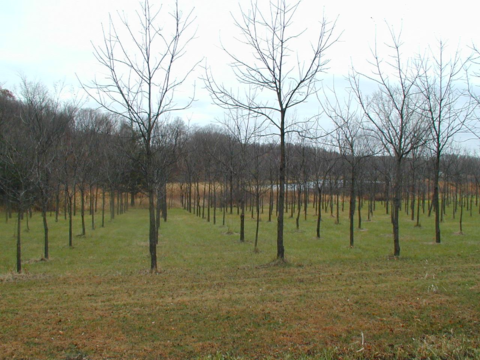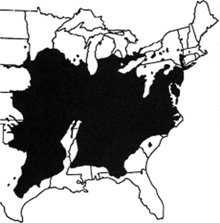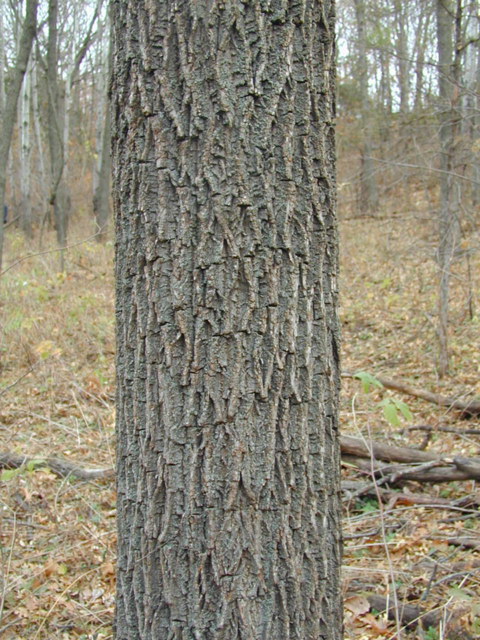Quick facts
- Pure stands of black walnut trees are uncommon.
- Black walnut grows best on lower north- and east-facing slopes with well-drained and fertile soils.
- Plant seedlings to supplement natural regeneration.
- Control weeds for at least three years in new black walnut plantations.
- The main pests of black walnut are walnut caterpillars, bud borers, anthracnose and fusarium canker.
Wood products from black walnut include sawlogs, veneer logs, gun stocks and smaller novelty pieces. Frequent nut crops make it an excellent tree to plant for wildlife, especially squirrels. In some areas, nuts are collected and sold for human consumption.
Growing conditions
You will generally find black walnut scattered among other tree species. Pure stands are not common, but do occur.
Black walnut leaves and roots actively secrete material that’s toxic to some trees, shrubs and herbaceous plants.
Plants for under a black walnut tree
| Botanical Name | Common Name | Height | Comments |
|---|---|---|---|
| Alcea rosea | hollyhock | 4-8' | Full sun with rich soil; half-hardy biennial, reseeds like a perennial. |
| Arisaema triphyllum | Jack-in-the-pulpit | 8-24" | Flower or "pulpit" is 3-4" green leaf-like hood; red berries in fall. |
| Astilbe x arendsii | astilbe | 1-2' | Fernlike foliage; clusters of tiny flowers; heavy feeders; may need irrigation. |
| Begonia sempervirens & hybrids | wax begonia | 8"-2' | Attractive foliage; white, pink, rose or red flowers. |
| Calendula officinalis | pot marigold | 12 - 24" | Gold, red or yellow flowers all summer; all soils. |
| Campanula latifolia | bellflower | 2-4' | Bell-like, purplish blue flowers; spreads freely by rhizomes and seeds. |
| Chionodoxa luciliae | glory-of-the-snow | 6" | Early flowering bulb; violet-blue, six petal, star-like flowers. |
| Claytonia virginica | spring beauty | 3-6" | Flowers are white with fine pink stripes; wide variety of soils. |
| Crocus vernus | crocus, giant crocus | 4-6" | Very early spring flowering bulb; prefers sandy, well-drained soil. |
| Dicentra cucullaria | dutchman's breeches | 6-12" | White upside down "breeches" for flowers; prefers fertile moist soil. |
| Galanthus nivalis | snowdrop | 3-10" | One of the earliest flowers; dainty white flowers with green markings. |
| Galium odoratum | sweet woodruff | 4-12" | Dainty-looking groundcover with late spring white flowers. |
| Geranium sanguineum | cranesbill | 12-18" | Attractive foliage; tough; many cultivars. |
| Heuchera spp. | coral bells | 12-20" | Small red, pink, or white tiny bell-shaped flowers; good drainage is essential. |
| Hyacinthoides hispanica | Spanish bluebell | 12-15" | Woodland garden; grows into robust clumps; average to rich well-drained soil. |
| Ipomoea 'Heavenly Blue' | morning glory | 10' | Blooms early summer to fall; blue trumpet-shaped flowers; vine. |
| Monarda didyma | bee balm | 2-4' | Requires good air circulation to prevent powdery mildew; moist soil is best. |
| Oenothera fruticosa | sundrops | 15" | Reliable; yellow flowers; well-drained soil; sun. |
| Osmunda cinnamomea | cinnamon fern | 2-4' | Large, yellowish-green fronds; prefers moist, humus-rich soil. |
| Phlox paniculata | garden phlox | 3-4' | Common perennial; rich, well-drained soil. |
| Poa pratensis | Kentucky bluegrass | 2-28" | Sod-forming lawn grass; tolerates cold, heat, rain, but not shade or wet. |
| Pulmonaria species | lungwort | 8-18" | Pink, violet, and blue flowers; prefers evenly moist, humus-rich soil. |
| Sanguinaria candensis | bloodroot | 8-10" | White flowers in April; moist, humus-rich soil. |
| Scilla siberica | Siberian squill | 6" | Early spring; blue flowers; moist soil; naturalizes by seed and off sets. |
| Stachys byzantina | lamb's ear | 6-15" | Large silvery very soft leaves; prefers well-drained, sandy loamy soil. |
| Tradescantia virginiana | spiderwort | 18-24" | Long blooming flowers; grass-like foliage; well-drained soil. |
| Zinnia spp. | zinnia | 1-3' | Easy to start from seed; many colors and flower forms. |
Walnut grows best on lower north- and east-facing slopes, stream terraces and floodplains. It is common on limestone soils and grows well on well-drained and fertile soils.
Poor sites for walnut include steep south- and west-facing slopes, narrow ridgetops and poorly drained sites. Soils with a high amount of sand or sites where bedrock is within two and a half feet of the surface are not suitable.
Regenerating black walnut
You can naturally regenerate black walnut from seed, but black walnut trees are normally a minor component of a woodland so you can rarely rely on natural regeneration. Stumps sprout if trees are less than 20 to 30 years old. Plant seedlings to supplement natural regeneration.
Plant seedlings at a spacing of 10 by 10 feet to produce timber, and 15 by 15 feet to produce a combination of timber and nuts. Black walnut won’t tolerate shade.
To prepare a woodland site, cut or kill all woody vegetation with diameters larger than half an inch with herbicides. Grassy and weedy sites may need herbicide treatments to kill existing vegetation before you plant seedlings.
Plant seedlings in the spring as soon after the ground thaws as possible. Seedlings at least 1/4 inch in diameter at 1 inch above the root collar will compete better with weeds and have a better survival rate than smaller seedlings.
Seeds are easier and less expensive to plant than seedlings, but should be protected from squirrels and other rodents.
Mechanical barriers (hardware cloth, tin cans, etc.) are the most reliable, but they’re expensive and time-consuming to install. Alternatively, direct seeding a large area can overwhelm seed predators. This approach is becoming more common in Minnesota.
You can sow seed in either the fall or spring. You don’t need to remove the husks for fall planting. Spring planting eliminates overwinter feeding by rodents, but you must stratify seed before planting to break dormancy. Stratification involves subjecting the seed to cold temperatures and regulating moisture for a period of time.
The rotation length for black walnut is between 50 and 80 years.
Intermediate treatments
When establishing a walnut plantation, control weeds for at least three years. This maximizes the sunlight, moisture and minerals available to walnut seedlings and reduces plant cover that encourages rodents.
Control weeds by mowing or cultivation in open field plantings. But in most situations, herbicides are more cost-effective and will not damage the walnut stems or roots.
Corrective pruning can improve seedling form if there is tip dieback or stem forking. Don’t prune too heavily; young stems have a strong natural tendency to grow upright. Clear-stem pruning is recommended to help produce knot-free wood.
You generally do not need to fertilize on a good black walnut site unless a specific nutrient element is deficient. To find out if there are nutrient deficiencies, analyze the foliage. Weeds are the usual benefactors of fertilizers.
Thin the stand lightly and frequently — perhaps every 10 years — to maintain rapid, uniform growth. After thinning, at least three-fourths of the crown of crop trees should be at least 5 feet away from the crowns of adjacent trees.
Cut or girdle competing trees. To girdle a tree, remove a strip of bark around its trunk. Then, treat with an herbicide to prevent resprouting.
Dominant and codominant trees will respond best to thinning. Dominant trees extend their crown above the canopy, while the crowns of codominant trees are lower, only extending into the canopy. Both receive full light from above, but dominant trees receive more from the sides.
The major pests of black walnut are walnut caterpillars, bud borers, anthracnose and fusarium canker. Pesticides usually are not economical.
Here are some guidelines for controlling these pests:
- Caterpillars - You may need insecticides.
- Anthracnose - You may need fungicides to improve nut production. To manage anthracnose, control the weeds that weaken the trees.
- Fusarium canker - Restrict pruning to late winter.
If you prune incorrectly, it can lead to serious problems, including fusarium canker, bark necrosis and sunscald. Fire is highly damaging to black walnut.
CAUTION: Mention of a pesticide or use of a pesticide label is for educational purposes only. Always follow the pesticide label directions attached to the pesticide container you are using. Be sure that the area you wish to treat is listed on the label of the pesticide you intend to use. Remember, the label is the law.
Reviewed in 2019




